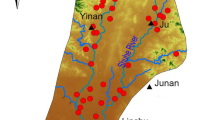Abstract
This study was undertaken to investigate the redox potential (Eh) of sulfidic groundwater in unconsolidated sediments. The Eh was determined by long-term (several days to several weeks) continuous in situ potentiometric measurements using a platinum (Pt) electrode. The Eh values measured in two monitoring campaigns were −259 and −202 mV, respectively. Chemical analysis of groundwater showed that the redox species in the groundwater were sulfide (S2 − ) and iron, respectively. The saturation indices calculated from the chemical analysis results indicated that FeS(am) and mainly mackinawite were close to equilibrium in the analyzed waters. Comparison of the measured Eh values with those calculated using different redox couples revealed that the Eh values measured in the first monitoring campaign were nearly equal to those calculated using HS − /SO\(_{4}{^{2-}}\), S2 − /SO\(_{4}{^{2-}}\), FeS\(_{(\text{am})}\)/SO\(_{4}{^{2-}}\), and mackinawite/SO\(_{4}{^{2-}}\) redox couples; on the other hand, the Eh values measured in the second monitoring campaign were almost consistent with those measured using the FeS2/SO\(_{4}{^{2-}}\) redox couple. The good fit between the measured Eh values and the theoretical calculated Eh values suggests that the sulfur system is related to the Eh value of sulfidic groundwater in unconsolidated sediments.
Similar content being viewed by others
References
Auqué, L., Gimeno, M. J., Gómez, J., & Nilsson, A.-C. (2008). Potentiometrically measured Eh in groundwaters from the Scandinavian Shield. Applied Geochemistry. doi:10.1016/j.apgeochem.2008.02.016.
Benner, S. G., Blowes, D. W., Gould, W. D., Herbert, J. R. R. B., & Ptacek, C. J. (1999). Geochemistry of a permeable reactive barrier for metals and acid mine drainage. Environmental Science & Technology. doi:10.1021/es981040u.
Bethke, C. M. (2008). Geochemical and biogeochemical reaction modeling (2nd ed.). Cambridge: Cambridge University Press.
Brown, C. J., Coates, J. D., & Schoonen, M. A. A. (1999). Localized sulfate-reducing zones in a coastal plain aquifer. Ground Water. doi:10.1111/j.1745-6584.1999.tb01136.x.
Chapelle, F. H., McMahon, P. B., Dubrovsky, N. M., Fujii, R. F., Oaksford, E. T., & Vroblesky, D. A. (1995). Deducing the distribution of terminal electron-accepting processes in hydrogically diverse groundwater systems. Water Resources Research, 31, 359–371.
Chen, W. F., & Liu, T. K. (2005). Ion activity products of iron sulfides in groundwaters: Implications from the Choushui fan-delta, Western Taiwan. Geochimica et Cosmochimica Acta. doi:10.1016/j.gca.2005.03.007.
Christensen, T. H., Bjerg, P. L., Banwart, S. A., Jakobsen, R., Heron, G., & Albrechtsen, H.-J. (2000). Characterization of redox conditions in groundwater contaminant plumes. Journal of Contaminant Hydrology. doi:10.1016/S0169-7722(00)00109-1.
Davison, W., Phillips, N., & Tabner, B. J. (1999). Soluble iron sulfide species in natural waters: Reappraisal of their stoichiometry and stability constants. Aquatic Sciences. doi:10.1007/s000270050050.
Drever, J. J. (1997). The geochemistry of natural waters: Sufarce and groundwater environments (3rd ed.). Upper Saddle River: Prentice Hall.
Geological Survey of Hokkaido (1983). Hydrogeological maps of Hokkaido (No. 1). Wakkanai.
Gómez, P., Turrero, M. L., Garrralón, A., Peña, J., Buil, B., de la Cruz, B., et al. (2006). Hydrogeochemical characteristics of deep groundwaters of the Hesperian Massif (Spain). Journal of Iberian Geology, 32, 113–131.
Hama, K., Kunimaru, T., Metcalfe, R., & Martin, A. J. (2007). The hydrogeochemistry of argillaceous rock formations at the Horonobe URL site, Japan. Physics and Chemistry of the Earth. doi:10.1016/j.pce.2005.12.008.
Hockin, S. L., & Gadd, G. M. (2007). Bioremediation of metals and metalloids by precipitation and cellar binding. In L. L. Barton, & W. A. Hamilton (Eds.), Sulphate-reducing bacteria (pp. 405–434). Cambridge: Cambridge University Press.
Horiba, Ltd. (2001). MULTI-PROBE W-22XD.23XD Operation Manual (2nd ed., p. 118).
Iwatsuki, T., Arthur, R., Ota, K., & Metcalfe, R. (2004). Solubility constraints on uranium concentrations in groundwaters of the Tono uranium deposits, Japan. Radiochimica Acta. doi:10.1524/ract.92.9.789.54986.
Iwatsuki, T., Morikawa, K., Hosoya, S., & Yoshikawa, H. (2009). A notice for measuring physicochemical parameters (pH, ORP) of deep groundwater. Journal of Groundwater Hydrology, 51, 205–214 (in Japanese with English abstract).
Lindberg, R. D., & Runnells, D. D. (1984). Ground water redox reactions: An analysis of equilibrium state applied to Eh measurements and geochemical modeling. Science. doi:10.1126/science.225.4665.925.
Ludwig, R. D., McGregor, R. G., Blowes, D. W., Benner, S. G., & Mountjoy, K. (2002). A permeable reactive barrier for treatment of heavy metal. Ground Water. doi:10.1111/j.1745-6584.2002.tb02491.x.
McMahon, P. B., Cowdery, T. K., Chapelle, F. H., & Jurgens, B. C. (2009). Redox conditions in selected principle aquifers of the United State. USGS Fact Sheet 2009–3041.
Morris, J. C., & Stumm, W. (1967). Redox equilibria and measurements of potentials in the aquatic environment. Advances in Chemistrty. doi:10.1021/ba-1967-0067.ch013.
Parkhurst, D. L., & Appelo, C. A. J. (1999). User’s guide to PHREEQC (version 2), a computer program for speciation, batch-reaction, one-dimensional transport and inverse geochemical calculations. U.S. Geological Survey Water-Resources Investigations Report 99-4259.
Peiffer, S., Klemm, O., Pecher, K., & Hollerung, R. (1992). Redox measurements in aqueous solutions—A theoretical approach to data interpretation, based on electrode kinetics. Journal of Contaminant Hydrology. doi:10.1016/0169-7722(92)90041-C.
Power, G. P., & Ritche, M. (1983). Mixed potentials. Journal of Chemical Education. doi:10.1021/ed060p1022.
Rickard, D. (1989). Experimental concetration–time curves for the iron (II) sulfide precipitation process in aqueous solutions and their interpretation. Chemical Geology. doi:10.1016/0009-2541(89)90066-1.
Schoonen, M. A. A. (2004). Mechanisms of sedimentary pyrite formation. In P. Amend, K. J. Edwards, & T. W. Lyons (Eds.), Sulfur biogeochemistry: Past and present (pp. 117–134). Colorado: GSA.
Smedley, P. L., & Edmunds, W. M. (2002). Redox patterns and trace-elements behavior in the East Midlands Triassic sandstone aquifer, U.K. Ground Water. doi:10.1111/j.1745-6584.2002.tb02490.x.
Stefánsson, A., Arnórsson, S., & Sveinbjörnsdóttir, Á. E. (2005). Redox reactions and potentials in natural waters at disequilibrium. Chemical Geology. doi:10.1016/j.chemgeo.2005.06.003.
Walter, D. A. (1997). Geochemical and microbiology of iron-related well screen encrustation and aquifer biofouling in Suffolk County, Long Island, New York. U.S. Geological Survey Water-Resources Investigations Report 97-4032.
Whitfield, M. (1974). Thermodynamics limitations on the use of the platinum electrode in Eh measurements. Limnology and Oceanography, 19, 857–865.
Author information
Authors and Affiliations
Corresponding author
Rights and permissions
About this article
Cite this article
Ioka, S., Sakai, T., Igarashi, T. et al. Determination of redox potential of sulfidic groundwater in unconsolidated sediments by long-term continuous in situ potentiometric measurements. Environ Monit Assess 178, 171–178 (2011). https://doi.org/10.1007/s10661-010-1680-4
Received:
Accepted:
Published:
Issue Date:
DOI: https://doi.org/10.1007/s10661-010-1680-4




